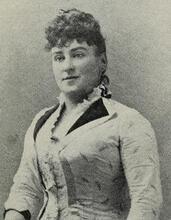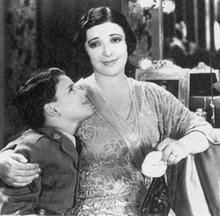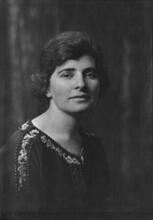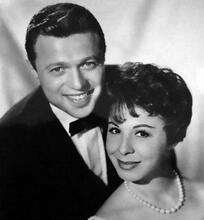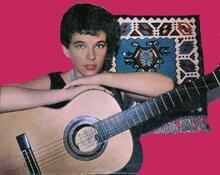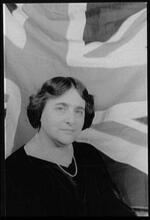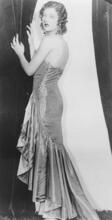Helen Forrest
Helen Forrest in 1945, holding a ration book and wearing a blouse with the word "ration" printed on it.
Courtesy of CBS Fashions/Wikimedia Commons.
Despite an unhappy childhood, Helen Forrest achieved great success as a singer in several big bands. She got her start singing in commercials and then moved to a supper club, where Artie Shaw came and invited her on tour. She then joined Benny Goodman’s band for two years, and after that joined the Harry James band. Traveling with the band, Forrest was the only woman among eighteen or more band members. During the early big band era, few women vocalists had the confidence to ask for individualized arrangements. Helen Forrest was one of the first singers in the big band era whose vocals were featured throughout a full band arrangement. She continued to record, achieving several solo hits, in addition to her band recordings.
When Helen Forrest joined the Harry James band in 1941, she broke new ground for American vocalists. She asked that specific arrangements be written just for her and that the band accompany her lead vocal. Harry James agreed, and Forrest went on to record five gold records: “But Not for Me,” “I Don’t Want to Walk Without You,” “I Cried For You,” “I’ve Heard That Song Before,” and “I Had the Craziest Dream.”
Early Life
Forrest was born Helen Fogel on April 12, 1918, in Atlantic City, New Jersey. Her parents, Louis and Rebecca Fogel, were Jewish and kept a Term used for ritually untainted food according to the laws of Kashrut (Jewish dietary laws).kosher home. She was the youngest of four children and the only girl; her three brothers were Harry, Ed, and Sam. The Fogels owned a little grocery store. But when Helen was an infant, her father became ill with influenza and suddenly died. Apparently, Helen’s mother became so distraught that she blamed her husband’s death on her daughter’s birth, believing that God had taken away Louis because she had wished so much for a little girl.
The two oldest brothers, Harry and Ed, were old enough to live on their own when Rebecca Fogel moved to Brooklyn with her two youngest children. There, Helen’s mother met and married a housepainter by the name of Feigenbaum. Forrest recalled that her parents often asked her not to come home right away after school. As she got older, she began to realize that during the day her home was a brothel. As Helen matured physically, her stepfather tried to accost her sexually. She told her mother of his attempts, but Rebecca Fogel did not believe her daughter. When Helen was about fourteen, her stepfather trapped her in the kitchen, and she defended herself with a kitchen knife. Subsequently, she went to live with her piano teacher, Honey Silverman, and Silverman’s family. While Helen completed grammar school, she continued to take piano lessons, but when Silverman heard her sing, she suggested that Helen concentrate on singing instead. Although Helen did not complete high school, she sang in the school musicals during her years of attendance.
Singing Career
I've heard that song before, 1942
By the time she was fourteen, her older brother Ed had his own band. During one summer, she sang with her brother’s band in Atlantic City. Helen later decided that she wanted to be singer and left for New York City, where she visited song publishers and auditioned for a fifteen-minute air slot for a local radio show. During one of the radio spots, the story goes, a sax player thought that the name Fogel was “too Jewish,” and therefore Helen Fogel changed her name to Helen Forrest. In 1934, at seventeen years of age, Forrest got her first job at WNEW, New York, singing commercials. During this time, she sang under anonymous names such as Helen, Hilee, Madlene, and Arlene. When she sang for WCBS, she became “Bonnie Blue” and “The Blue Lady of Song.” When her brother Ed, whose band was playing in Washington, D.C., called her to let her know that there was an opening for a vocalist in the Washington Madrillon Club, Forrest auditioned and soon after began singing in the popular supper club.
While performing at the Madrillon, she gained a reputation for her singing, and bandleader Artie Shaw came to see her. Shaw’s singer Billie Holiday was planning to leave the band, and in 1938 Shaw asked Forrest to go on tour. During the fifteen months she sang with Artie Shaw, his band recorded forty-one sides for RCA Victor’s Bluebird record label. In 1939, while still on the road with Artie Shaw’s band, Forrest married drummer Al Spieldock in Baltimore. Her husband remained in Baltimore, and Forrest resumed her tour. When Shaw dissolved his band, she went back to Baltimore but was soon asked to join Benny Goodman’s band. During her two-year tenure with Goodman, she recorded fifty-three sides. In 1941, she joined the Harry James band. The musical alliance of featuring Forrest’s vocals with the band as accompaniment proved very successful.
Traveling with the band, Forrest was the only woman among eighteen or more band members. She fell in love with Harry James, maintaining a sporadic love affair until James married actor Betty Grable. In 1943, a few months after James’s marriage, Forrest left the band and appeared in clubs around the country. Her husband divorced her about the same time. Forrest’s agent teamed her up with vocalist Dick Haymes, and together they appeared on their own very popular radio program, running from 1944 to 1947.
Later Work and Influence
Around 1945, Forrest met Paul Hogan, an aspiring actor, at a party. The two began living together and married in 1947. They later separated and divorced in 1956. In the late 1950s, she met businessman Charlie Feinman and married him in 1959. The couple had a son, Michael, in 1960, but the marriage was dissolved in 1961. She continued to perform in major supper clubs around the country, sometimes singing for movie sound tracks as well as performing in “big band nostalgia” tours. She continued to record, achieving several hits as a soloist and several hits singing duets with Dick Haymes. Forrest recorded approximately seventy-four songs as a solo vocalist—twenty-two for Decca Records, forty for MGM, and twelve for Bell Records. In addition, she recorded for Capitol in 1955–1956, singing the hits she had sung with Harry James. From 1969 to 1974, she rerecorded some of her hits for Reader’s Digest and Time-Life as well. During various periods of “big band nostalgia,” radio broadcasts and shorts were rereleased of Helen Forrest with Artie Shaw’s band, Benny Goodman’s band, Harry James’s band, and Dick Haymes.
Helen Forrest was one of the first singers in the big band era whose vocals were featured throughout a full band arrangement. Before this time, big band vocalists usually sang in the middle of a song. The band would be featured for a full chorus, the vocalist would sing one chorus, and then the band would play another chorus. This arrangement usually confined the singer, not allowing much improvisation in the rhythmic phrasing or melodic line. As well, the song was usually set in the key that suited the instrumentalists’ playing, rather than the vocalist’s range. During the early big band era, few women vocalists had the confidence to ask for individualized arrangements. Despite an unhappy childhood, frequent illness, and personal disappointments, Forrest remained dedicated to her musical profession until the 1980s.
Helen Forrest died on July 11, 1999.
Forrest, Helen, and Bill Libby. I Had The Craziest Dream (1982).
Friedwald, Will. Jazz Singing: American’s Great Voices from Bessie Smith to BeBop and Beyond (1990).
Gourse, Leslie. Louis’ Children: American Jazz Singers (1984).
Kinkle, Roger D. Complete Encyclopedia of Popular Music and Jazz, 1900–1950 (1974).
Penguin Encyclopedia of Popular Music. Edited by Donald Clarke (1987).
Schuller, Gunther. The Swing Era (1989).
Simon, George T., et al. The Best of the Music Makers (1979).



